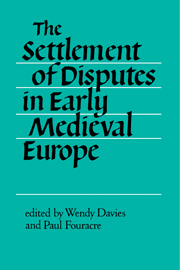Book contents
- Frontmatter
- Contents
- List of figures
- Preface
- Abbreviations
- Introduction
- 1 Disputes in late fifth- and sixth-century Gaul: some problems
- 2 ‘Placita’ and the settlement of disputes in later Merovingian Francia
- 3 Dispute settlement in Carolingian West Francia
- 4 People and places in dispute in ninth-century Brittany
- 5 Visigothic law and regional custom in disputes in early medieval Spain
- 6 Land disputes and their social framework in Lombard–Carolingian Italy, 700–900
- 7 Dispute settlement in the Byzantine provinces in the tenth century
- 8 Charters, law and the settlement of disputes in Anglo-Saxon England
- 9 Dispute settlement in medieval Ireland: a preliminary inquiry
- 10 An early modern postscript: the Sandlaw dispute, 1546
- Conclusion
- Appendix texts of the documents discussed
- Glossary
- List of works cited
- Index
1 - Disputes in late fifth- and sixth-century Gaul: some problems
Published online by Cambridge University Press: 11 January 2010
- Frontmatter
- Contents
- List of figures
- Preface
- Abbreviations
- Introduction
- 1 Disputes in late fifth- and sixth-century Gaul: some problems
- 2 ‘Placita’ and the settlement of disputes in later Merovingian Francia
- 3 Dispute settlement in Carolingian West Francia
- 4 People and places in dispute in ninth-century Brittany
- 5 Visigothic law and regional custom in disputes in early medieval Spain
- 6 Land disputes and their social framework in Lombard–Carolingian Italy, 700–900
- 7 Dispute settlement in the Byzantine provinces in the tenth century
- 8 Charters, law and the settlement of disputes in Anglo-Saxon England
- 9 Dispute settlement in medieval Ireland: a preliminary inquiry
- 10 An early modern postscript: the Sandlaw dispute, 1546
- Conclusion
- Appendix texts of the documents discussed
- Glossary
- List of works cited
- Index
Summary
The procedures for settling disputes in the great law courts of the Roman empire are well known. For the fourth and fifth centuries the Codex Theodosianus provides an invaluable guide. Similarly law books provide a key to the legal processes of the Germanic kingdoms, whilst specific cases are recorded in documents known to modern historians as placita, which survive, particularly in north Francia, from the seventh century onwards. Despite the absence of such documents from earlier periods, it has been suggested with reason that the placitum developed out of the Roman charter. Nevertheless it is worth noting that the development of the placitum, like that of the charter itself, can only be inferred and not demonstrated directly. It may be significant that no genuine specimen is known from the Merovingian kingdom before 625 and that the surviving examples come from the relatively new monastic world of northern Francia, not from the well-established urban administrative centres of the south. The towns of the north were undoubtedly less important than their southern counterparts and in all probability their rôle in local administration was correspondingly less significant. Moreover the monasteries of the region were young, powerful and rural, with no particular interest in upholding the remnants of the city-based administrative system of Roman Gaul. These factors may in part explain the emergence of the placitum in the early seventh century; if so, they provide a powerful illustration of the need to place the development of legal procedure in a general context.
The origins of the placitum in many ways provide a paradigm of the problems facing the would-be historian of sixth-century dispute settlement.
- Type
- Chapter
- Information
- The Settlement of Disputes in Early Medieval Europe , pp. 7 - 22Publisher: Cambridge University PressPrint publication year: 1986
- 54
- Cited by



